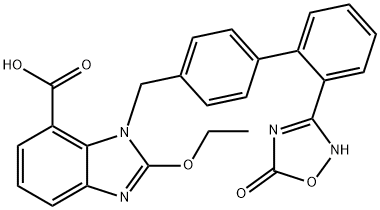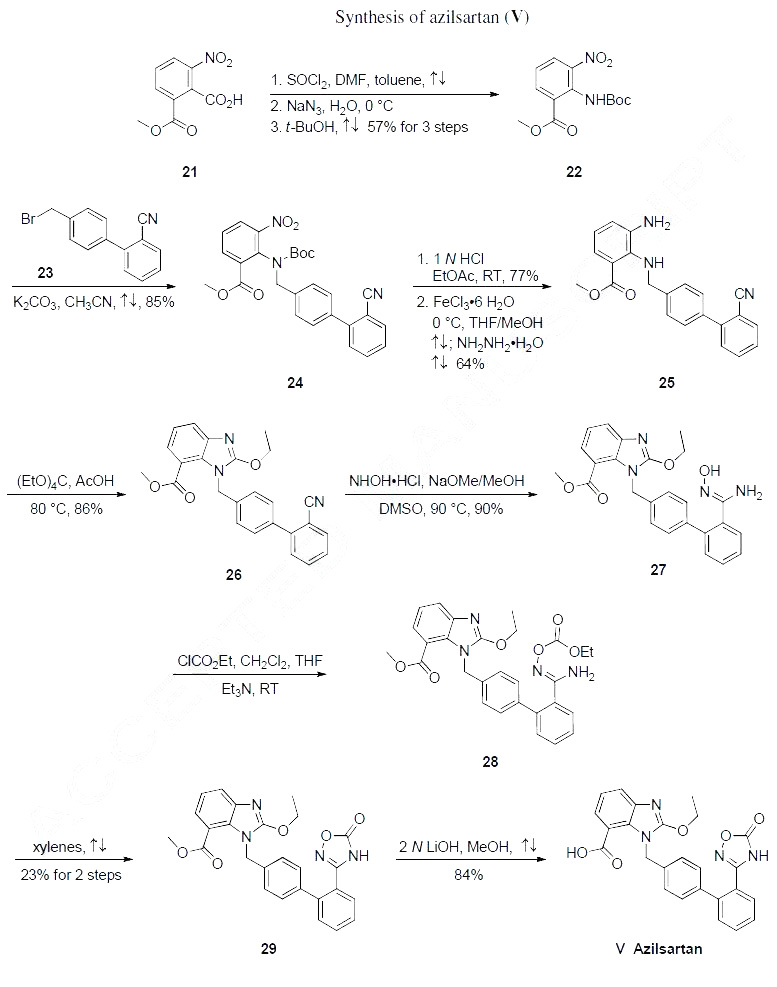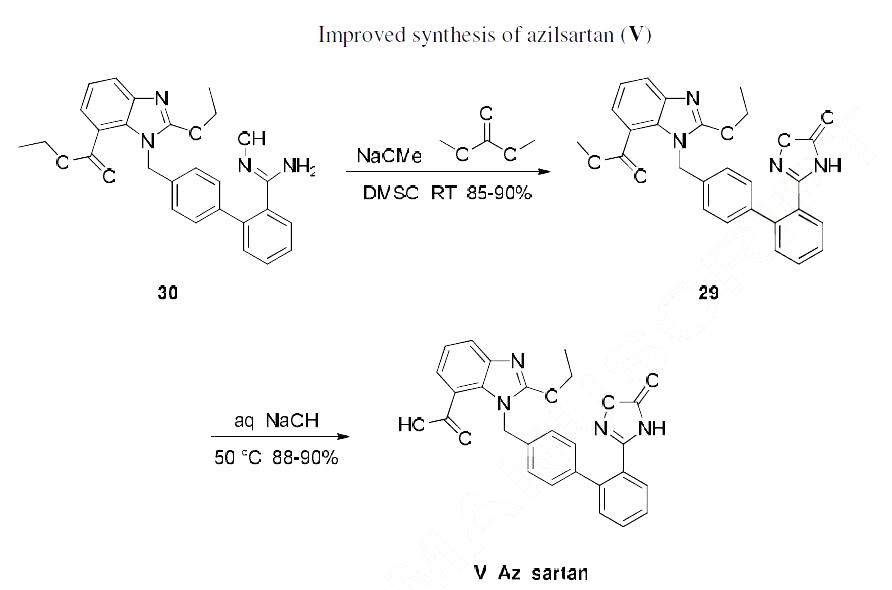
Azilsartan synthesis
- Product Name:Azilsartan
- CAS Number:147403-03-0
- Molecular formula:C25H20N4O5
- Molecular Weight:456.45


An improved scalable route (Scheme below) to azilsartan was reported and features reproducibly better yields.43 Hydroxyamidine 30 was treated with dimethyl carbonate and sodium methoxide, which triggered they key cyclization along with concomitant transesterification to deliver 29. Milder aqueous sodium hydroxide hydrolysis converted this methyl ester 29 to azilsartan (V) in 88-90% yield.
![1H-BenziMidazole-7-carboxylic acid, 1-[[2'-(2,5-dihydro-5-oxo-1,2,4-oxadiazol-3-yl)[1,1'-biphenyl]-4-yl]Methyl] -2-ethoxy-, ethyl ester](/CAS/GIF/1403474-70-3.gif)
1403474-70-3
99 suppliers
$60.00/100mg

147403-03-0
521 suppliers
$5.00/50mg
Yield:147403-03-0 98.5%
Reaction Conditions:
with water;sodium hydroxide at 50; for 4 h;
Steps:
9 Example 9: Preparation of 2-ethoxy-l-((2'-(5-oxo-455-dihydro-l ,2,4-oxadiazol-3-yl)biphenyl- 4-yl)methyl)-lH-benzo[ ]-imidazole-7-carboxylic acid (III).
The starting ethyl ester of azilsartan (V, 250 g) was suspended in a solution of sodium hydroxide in water (56 g/800ml). The suspension was heated at 50°C for 4 h, after pH adjustment to 4-5, the product crystallized providing 232 g (98.5 %).
References:
WO2014/48404,2014,A1 Location in patent:Page/Page column 11
![(Z)-Methyl 2-ethoxy-3-((2'-(N'-(ethoxycarbonyloxy)carbaMiMidoyl)biphenyl-4-yl)Methyl)-3H-benzo[d]iMidazole-4-carboxylate](/CAS/20150408/GIF/147404-82-8.gif)
147404-82-8
21 suppliers
inquiry

147403-03-0
521 suppliers
$5.00/50mg
![(Z)-Ethyl-2-ethoxy-3-((2'-(N'-hydroxycarbaMiMidoyl) biphenyl-4-yl) Methyl)-3H-benzo[d] iMidazole-4-carboxylate](/CAS/GIF/1397836-41-7.gif)
1397836-41-7
72 suppliers
$514.00/1g

541-41-3
0 suppliers
$21.00/5g

147403-03-0
521 suppliers
$5.00/50mg
![1H-BenziMidazole-7-carboxylic acid, 1-[[2'-(2,5-dihydro-5-oxo-1,2,4-oxadiazol-3-yl)[1,1'-biphenyl]-4-yl]Methyl] -2-ethoxy-, Methyl ester](/CAS/GIF/147403-52-9.gif)
147403-52-9
220 suppliers
$9.00/250mg

147403-03-0
521 suppliers
$5.00/50mg
![1H-Benzimidazole-7-carboxylic acid, 2-ethoxy-1-[[2'-[imino[[(phenoxycarbonyl)oxy]amino]methyl][1,1'-biphenyl]-4-yl]methyl]-, methyl ester](/CAS/20210111/GIF/1403477-44-0.gif)
1403477-44-0
0 suppliers
inquiry

147403-03-0
521 suppliers
$5.00/50mg